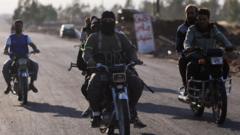The ongoing conflict between Israel and Iran has resulted in significant military engagements, prompting U.S. President Trump to seek decisive action as civilian casualties rise. Diplomatic efforts face challenges amid accusations and military maneuvers from both sides.**
Violence Escalates Between Israel and Iran Amidst Global Diplomacy Efforts**

Violence Escalates Between Israel and Iran Amidst Global Diplomacy Efforts**
Tensions soar as military confrontations between Israel and Iran intensify, garnering global attention and calls for peace from major leaders.**
The escalating violence between Israel and Iran has reached unprecedented levels, marking the fifth day of intense military hostilities. President Trump has returned to Washington from the G7 summit, where he indicated that he is pursuing a strategy "much bigger" than merely negotiating a cease-fire between the two long-standing adversaries. This significant return underscores the urgent need for U.S leadership as tensions escalate in the Middle East.
Israeli military actions have intensified, with claims of striking high-ranking Iranian military officials amid dropping civilian casualties, which have reportedly included at least 224 deaths in Iran and 24 fatalities in Israel since the outbreak of hostilities. The latest reports attribute the death of Iranian Major General Ali Shadmani to Israeli airstrikes, representing a continued strategy of severely disrupting Iran’s military command structure.
Trump's recent declarations reflect a contradictory stance on the conflict, advocating for a strong position against Iran while simultaneously hinting at ongoing diplomatic engagements. He has called for immediate evacuations of Tehran, emphasizing a preference for a conclusive end to Iranian nuclear ambitions rather than temporary measures.
International reactions have been swift, with the G7 leaders calling for de-escalation while affirming Israel's right to self-defense. As countries like China and South Korea begin facilitating the evacuation of their citizens from the war zones, the airspace around both Israel and Iran has been heavily restricted, complicating rescue operations.
Iran has retaliated against Israeli airstrikes, including strikes on civilian areas, leading to rising humanitarian concerns. Civilians in both countries face perilous conditions, with shortages of fuel and essential supplies beginning to manifest among populations in the midst of direct conflict.
Meanwhile, Syria, strategically key yet historically aligned with Iran, has shockingly refrained from voicing support for Iran in this conflict, signaling a potential shift in Middle Eastern alliances.
The situation remains dynamically precarious as diplomatic pathways continue to open, albeit with skepticism about their effectiveness amidst kinetic warfare. As both sides press forward with their military agendas, the international community watches closely, hoping for a breakthrough that can lead to meaningful peace negotiations rather than continued escalation and broader conflict.
President Trump’s administration balances the complicated geopolitics of the region, weighing military engagements against diplomatic negotiations, while many fear the consequences of a potential U.S. military involvement in Iran. With humanitarian conditions deteriorating rapidly, the urgency for a resolution is palpable amidst global calls for peace and stability.
Israeli military actions have intensified, with claims of striking high-ranking Iranian military officials amid dropping civilian casualties, which have reportedly included at least 224 deaths in Iran and 24 fatalities in Israel since the outbreak of hostilities. The latest reports attribute the death of Iranian Major General Ali Shadmani to Israeli airstrikes, representing a continued strategy of severely disrupting Iran’s military command structure.
Trump's recent declarations reflect a contradictory stance on the conflict, advocating for a strong position against Iran while simultaneously hinting at ongoing diplomatic engagements. He has called for immediate evacuations of Tehran, emphasizing a preference for a conclusive end to Iranian nuclear ambitions rather than temporary measures.
International reactions have been swift, with the G7 leaders calling for de-escalation while affirming Israel's right to self-defense. As countries like China and South Korea begin facilitating the evacuation of their citizens from the war zones, the airspace around both Israel and Iran has been heavily restricted, complicating rescue operations.
Iran has retaliated against Israeli airstrikes, including strikes on civilian areas, leading to rising humanitarian concerns. Civilians in both countries face perilous conditions, with shortages of fuel and essential supplies beginning to manifest among populations in the midst of direct conflict.
Meanwhile, Syria, strategically key yet historically aligned with Iran, has shockingly refrained from voicing support for Iran in this conflict, signaling a potential shift in Middle Eastern alliances.
The situation remains dynamically precarious as diplomatic pathways continue to open, albeit with skepticism about their effectiveness amidst kinetic warfare. As both sides press forward with their military agendas, the international community watches closely, hoping for a breakthrough that can lead to meaningful peace negotiations rather than continued escalation and broader conflict.
President Trump’s administration balances the complicated geopolitics of the region, weighing military engagements against diplomatic negotiations, while many fear the consequences of a potential U.S. military involvement in Iran. With humanitarian conditions deteriorating rapidly, the urgency for a resolution is palpable amidst global calls for peace and stability.






















